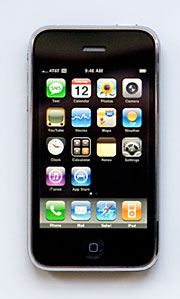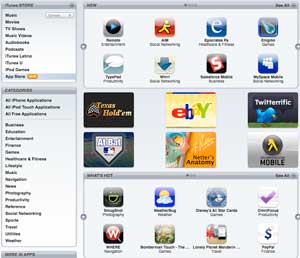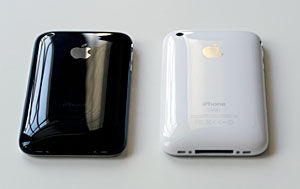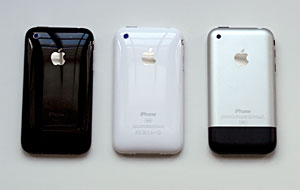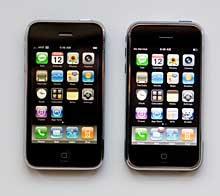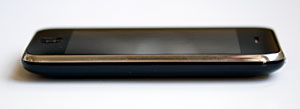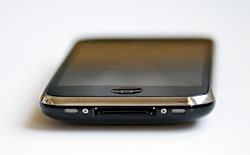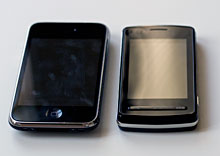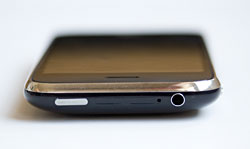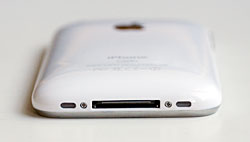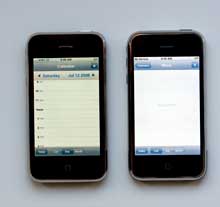
|
||||||||||||||
Same looks from the front, but a shiny new rear From the front, there's almost no difference between the original and 3G iPhone-- only the earpiece speaker grille has changed. The back and sides have undergone a transformation from metal / black plastic to all plastic. Apple says this improves reception. While metal speaks of quality, it does hinder RF and add weight (0.1 ounces in the iPhone's case). We'll take the shiny plastic iPhone 3G any day because it not only looks even better but feels better in hand. The original iPhone's flat slab design wasn't terribly comfy to hold while the curved back on the new model fits in the palm more naturally. The downside is that the curvy, shiny plastic is like a bar of soap in the tub-- it has a tendency to squirt out of your hand. The 8 gig model is currently available in black and the 16 gig is available in black and white. Both are high gloss, but only the black model shows fingerprints like mad.
The tempered glass front is extremely scratch resistant, just as with the iPhone 2G. But the plastic back obviously isn't as durable as the aluminum-backed iPhone 2G. While ours didn't pick up scratches easily like the infamous iPod Video 5th gen., it can be intentionally marred with keys or a table knife. Now, most of us try not to subject our phones to intentional damage, so don't get too worried about your new baby scarring easily, but it probably will pick up a few over time. I'd say the risk of damage from dropping the slippery phone are much greater than scratching the heck out of it if you're a careful person. 3G: a Primer for those who are new to it and a comparative measure of reception in -db First lesson for those new to AT&T and/or new to 3G. You will not necessarily see the same number of bars on 2G (EDGE) as 3G. Why? They are served by different cell tower panels on very different frequencies throughout most of the US. This is also true of Verizon, who serves 1x and EVDO on separate bands and whose signal indicators show two different levels. AT&T serves GSM and EDGE primarily on the 850MHz band which has shorter range but greater building penetration (that's how AT&T gets you full bars of EDGE inside your house or a building). 3G is currently mostly on the 1900MHz band, which travels farther but isn't as good at penetrating buildings. AT&T will eventually migrate 3G to their 850MHz band, but they have to do this slowly because there are still plenty of EDGE phones in customers' hands. So 2G and 3G are two separate signals, and in fact use 2 different radios inside the phone. What does this mean to you? If you had an iPhone 2G that got full bars and now your iPhone 3G shows fewer bars when on 3G, it doesn't mean the iPhone 3G has weaker reception, it means that AT&T's 3G signal isn't as strong as their 2G EDGE signal. In our experience traveling with and reviewing 3G phones in the past 2 years, we can say that AT&T's 3G signal is weaker than 2G. It's still usable and works fine for both voice and data. You don't have to see full bars to make calls and use data. But if you're down to 1 bar, data transfer speeds will be slower and calls may warble. AT&T has stated they'll be expanding and improving their 3G network aggressively thanks to iPhone 3G adoption and their overall transition to 3G handsets.
Lesson 2: Bars mean less than we'd all like. Cell phone signals are measured in decibels as negative numbers, with lower numbers being better. A -80db signal is very good, -70 is super-excellent and rare unless you're standing beside the tower. Anything over -110 borders on no reception. Decibels are the only true way to compare reception on phones, but phones don't display this info; instead they show bars. It's up the manufacturer to equate bars to signal level in -db, and they all do it differently. Nokia shows more bars relative to a given signal than do Apple or LG for example. There are utilities, sometimes pre-installed on the phone (field test) but hidden, or available for download for smartphones like Nokia S60. We compared the iPhone 3G and Nokia N95-3 US 3G edition (a phone with excellent reception and voice quality) side-by-side in a 3G coverage area and here's what we found: * Indoors: Nokia N95 shows nearly full bars on 3G. iPhone shows 2 bars. As measured in -db, the Nokia was pulling -94 to -101db (those bars aren't very accurate!). iPhone shows 2 bars and was pulling -95 to -101db. Further comparison to the LG Vu (also 3G phone): The Vu is many things, but it's no RF demon. In the same location for indoors tests (not running a field test) it does worse that the iPhone and Nokia. It shows the same bars as the iPhone, but hold it in your hand and it drops to EDGE. If it rains, it drops to EDGE. Voice quality suffers when 3G is at 1-2 bars. In comparison, the iPhone has yet to drop to EDGE/drop a call/have poor voice quality. You can run field test on your iPhone by opening the keypad screen, then entering *3001#12345#* and hitting the talk button. Look at the top left corner to see the signal in -db. Remember, compare 3G to 3G and 2G to 2G. For example, the BlackBerry Pearl 8120 is an EDGE phone and isn't good for 3G signal comparison, but is fine comparing 2G. Note that you can turn off 3G and use only EDGE if you wish (in settings). Beyond a much faster Internet experience (assuming moderate or better 3G coverage) and better voice quality, 3G allows you to use the Internet while talking on the iPhone. That means calls won't get sent directly to voicemail when you're surfing or downloading applications.
The iPhone 3G and the LG Vu. Call quality and the Web The original iPhone has just OK call quality and average volume. The iPhone 3G has excellent voice quality on 3G and very good quality on 2G GSM (3G's voice quality is inherently better because it uses a higher quality, higher bandwidth voice codec). Volume is louder, though it's still by no means a very loud phone. The speakerphone is noticeably improved and it's both louder and fuller. Voice quality with Bluetooth headsets is also improved and we had excellent call quality with the Jawbone, Plantronics Discovery 655 and Jawbone 2 (the iPhone 3G sounds better with the new Jawbone model than any other phone we've tested). Alas, there's still no A2DP Bluetooth stereo support, a most glaring omission for an iPod-phone hybrid. There's still only support for Bluetooth headsets and car kits-- no tethering for use as a modem and no using external Bluetooth keyboards. And yes, there's still no voice dialing, though it looks like 3rd party companies are working on voice dialing solutions.
The power button, SIM card slot and 3.5mm headset connector are up top. The web is as luxurious as ever thanks to Safari. Nothing looks as good or works as well on a mobile device. With a fair to good 3G signal (2-3 bars) in the DFW area, we managed 365k on average using DSL Reports mobile speed test, which lags behind some of the faster Windows Mobile devices like the HTC Touch Dual and the Nokia N95. With a 5 bar signal we got an excellent 780k average download speed that's as good as it gets on any phone in our area. When AT&T's 3G network bogged down the weekend of the iPhone launch, we switched to WiFi with a NetGear 802.11n router using WPA2 security and got better range than with the original iPhone (that plastic back helps). GPS One of the most exciting new features is the integrated GPS. The GPS works with a customized version of Google Maps, and the software is very similar to that found on the 1.x original iPhone firmware. Maps now uses the GPS, and it asks your permission to access the GPS each time you launch it. The GPS uses cell tower triangulation to speed up location, and in our tests it was one of the fastest we've used on a phone or PDA. It managed to accurately locate us in 10 seconds near a window inside and outdoors, and map downloads took only 5 seconds over 3G. This isn't a full-fledged navigation solution; maps can locate you, provide traffic info, track your progress on the map and provide on-screen directions to a location you enter or pull up from your address book but it doesn't have spoken turn-by-turn directions (a must when driving). TeleNav and Tom Tom are working on full-fledged navigation packages for the iPhone 3G, and we'll review those once they're available. Here's a 2 minute walkthrough of the Maps application's features in action: And here's our GPS driving test: www.youtube.com/watch?v=nxlsLX90jOU. Compatibility with 1st Gen iPhone and iPod Accessories The 30 pin iPod connector looks the same as the last gen iPhone and we had no problems using a several year old EDGE iPod dock, XtremeMac Luna clock radio and Griffin PowerDock. It doesn't fit in the JBL On Stage II nor the Altec Lansing inMotion 7. It fits in the Klipsch iGroove and i.Sound MAX speaker systems and plays music fine but doesn't charge. The new iPhone doesn't physically fit in the old iPhone's tiny dock so you can't use the old dock with the new iPhone. The new model comes with a USB cable and charger, but no dock (Apple sells a dock separately).
The original iPhone didn't play nicely with iPod speaker systems and generated interference (buzzing emitted through the speakers). This wasn't the iPhone's fault but rather 850MHz GSM, used by AT&T throughout much of the US, interferes with unshielded speakers. If you're in a 3G 'hood, you'll no longer hear that buzzing or need to turn off the iPhone's cell radio to use speakers because AT&T's HSDPA is largely on the 1900MHz band which doesn't affect unshielded speakers. iPod features and display The iPhone 3G is a fantastic mobile video and music player. That much was established with the launch of the original iPhone. We won't go over old features but we will say that audio quality from the speaker and through headphones in improved. And we're happy that the headphone jack is no longer recessed, making it easier to use any 3.5mm jack headphones. The new display is warmer, described by some folks as yellow, and this isn't a defect. Apple changed the color temperature of the display to achieve more natural and rich colors. We like it just fine, and wouldn't have noticed the change until we played our old iPhone 2G beside the new model. Like the iPhone 2G, the 3G iPhone's display is viewable outdoors even in direct sunlight.
The iPhone 3G's screen on the left is warmer and more yellow than the 2G iPhone on the right. Battery Life Like the iPhone 2G, the new iPhone's battery is sealed inside its pretty casing. You can't open a battery door (there is none) and swap in a new battery. Why? Battery compartments add significant thickness, and Apple thought it worth the risk to pursue thinness rather than practicality. Now, if you're the average person who's at a desk or near an outlet during part of your workday and overnight, you may not care. Most phone users don't own 2 batteries for their phone. But business travels and others on the go all day long who use the phone heavily won't be thrilled.
The new charger design is incredibly compact. Not that the iPhone has poor talk times by 3G standards. Apple claims 5 hours of talk time and in our tests, we got 5 hours and 41 minutes-- better than most 3G phones we've reviewed. 2G talk time is 10 hours according to Apple and we saw nearly that. Video playback and 3D gaming will eat the battery faster than talking, as will web browsing over 3G or WiFi. In our tests, we got 4 hours and 43 minutes of continuous video playback watching movies downloaded from iTunes (push on) and 6 hours 17 minutes (push off). These are high quality VGA movies that work the processor harder than homebrew mobile encoded QVGA video or saved YouTube video, and we expect longer playback times watching those. Web surfing over 3G with brightness set to auto and push on but WiFi off lasted us 3 hours and 37 minutes, which is shorter than the iPhone 2G's EDGE surfing time. 30 minutes of Moto Racer ate 20% of the charge. Graphically simpler games like JirboBreak didn't consume nearly as much power. Apple claims that the iPhone can play music for 24 hours, and our tests show that's accurate. No fears of running out of juice after listening to tunes throughout a trans-atlantic flight. Conclusion: is the iPhone 3G worth it? The iPhone 3G is certainly the most fun and easy to use phone available today and for the foreseeable future. Yet it brings smartphone features to the table and a very powerful Internet experience-- two things not usually associated with fun and easy. If AT&T has good service in your area and you like touch screens, the iPhone is certainly worth the $199 (8 gig) to $299 (16 gig) price of admission. The cost doesn't end there since AT&T requires a data plan, so the base cost is $70/month for service with 450 minutes of prime time talk time and unlimited data with 5,000 weekend minutes (text messages are extra). If you're a hardcore BlackBerry or Windows Mobile user who needs all the Exchange features those phones offer, including expedient folder management, tasks and notes syncing, the iPhone's current software doesn't measure up. But if you just want calendar and contacts syncing with Exchange along with push email, the iPhone does a fine job. If you've little need for business tasks other than syncing to your desktop and want to have a fantastic media player experience and the best touch screen experience, the iPhone is the way to go. Likewise, if you're into gaming, the first iPhone games in the app store tell us this is going to be a fantastic platform that far exceeds other phones (even Nokia's N-Gage 2.0). If you've already got an iPhone 2G on AT&T, the iPhone 3G is worth it if you're in a good 3G coverage area or if you need the GPS. But keep in mind that spoken turn-by-turn navigation isn't here yet. That may take a few months. The camera quality and iPod features remain the same. Pro: Fast, fantastic touch screen experience, easy to use yet powerful enough to handle syncing, Exchange and other business tasks. The 3.5" display is one of the best we've seen on a mobile device. Great music and video playback, as you'd expect from an iPod family product. Good 3G speeds and very good voice quality. One of the prettiest consumer electronics devices on the market if not the sexiest. Apple store staff and support folks are generally more helpful and knowledgeable than most high tech sales and support staff. WiFi and GPS put the iPhone on par with other high end feature phones and smartphones. Can easily turn off 3G and switch to EDGE via settings to save battery power or if you're located in a non-3G coverage area. Con: Still no user replaceable battery (a bigger hurt thanks to 3G's power consumption), MMS, video shooting or copy and paste. The 2 megapixel camera isn't exactly cutting edge. No tasks or notes syncing.
Price: $199 for the 8 gig and $299 for the 16 gig with a 2 year contract. Web sites: www.apple.com, wireless.att.com Warranty: 1 year.
| ||||||||||||||

